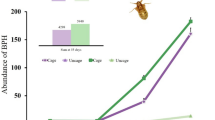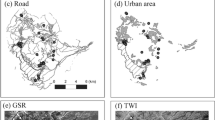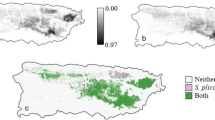Abstract
The spread of invasive species is a complex ecological process that is affected by both the biology of the species and the spatial structure of a landscape. The rice water weevil (Lissorhoptrus oryzophilus Kuschel), a notorious crop pest found in many parts of the world, is one of the most devastating invasive species in China, and has caused enormous economic losses and ecological damage. Little is known, however, as to how habitat and landscape features affect the spatial spread of this pest. Thus, the main goal of this study was to investigate the relationship between the observed spread pattern of L. oryzophilus and landscape structural factors in Zhejiang Province, China between 1993 and 2001. We quantified the invasive spread of the weevil in terms of both the proportion of infected area and spread distance each year as well as landscape structure and connectivity of rice paddies with landscape metrics. Our results showed that the spread of L. oryzophilus took place primarily in the southwest-northeast direction along coastal areas at a speed of about 36 km per year. The composition and spatial arrangement of landscape elements were key determinants of this unique spread pattern. In particular, the connectivity of early rice paddies was crucial for the invasive spread while other factors such as meteorological and geographical conditions may also have been relevant. To control the spread of the pest, we propose four management measures: (1) to implement a landscape-level planning scheme of cropping systems to minimize habitat area and connectivity for the pest, (2) to reduce the source populations at a local scale using integrated control methods, (3) to monitor and report invasive spread in a timely manner, and (4) to strengthen the quarantine system. To be most effective, all four management measures need to be implemented together through an integrated, multi-scaled approach.





Similar content being viewed by others
References
Andreassen HP, Halle S, Ims RA (1996) Optimal width of movement corridors for root voles: not too narrow and not too wide. Journal of Applied Ecology 33:63–70
Brett JG (2003) Is landscape connectivity a dependent or independent variable? Landscape Ecology 18:687–699
Brooker L, Brooker M, Cale P (1999) Animal dispersal in fragmented habitat: measuring habitat connectivity, corridor use, and dispersal mortality. Conservation Ecology 3:4
Cai Y, Liu SS, Song F, Wang X, Gao BZ, Chen HC (1997) Research on the spread of the rice water weevil in China (IV). Plant Quarantine 11:219–220 (in Chinese)
Chen H, Chen Z, Zhou Y (2005) Rice water weevil (Coleoptera: Curculionidae) in mainland China: invasion, spread and control. Crop Protection 24:695–702
Chinese National Agricultural Technical Extension Service Center (1998) Rice water weevil in China. China Agriculture Press, Beijing (in Chinese)
Clifford EK, Patrick JS, Alexander YK, Lyubov EB, Jeffrey CN, Ladd EJ, Dianna KP (2002) Landscape patterns of an aquatic invader: assessing dispersal extent from spatial distributions. Ecological Applications 12:749–759
Collinge SK (2000) Effects of grassland fragmentation on insect species loss, colonization, and movement patterns. Ecology 81:2211–2226
Crowl TA, Crist TO, Parmenter RR, Belovsky G, Lugo AE (2008) The spread of invasive species and infectious diseases as drivers of ecosystem change. Frontiers in Ecology and the Environment 6:238–246
Goh HG, Choi KM (1993) Forecasting methods of the rice water weevil in Korea. In: Hirai K (ed) Establishment, spread, and management of the rice water weevil and migratory rice pests in East Asia. NARC, Tsukuba, Japan, pp 133–162
Gu YQ, Lin YB, Yu JH (2002) Application and its effects on control and eradication technology for the rice weevil. Plant Protection 28:57–58 (in Chinese)
Guo YS (1996) Threat assessment of rice water weevil in Heibei, China and its quarantine strategies. Plant Quarantine 10:288–290 (in Chinese)
Haddad N (2000) Corridor length and patch colonization by a butterfly, Junonia coenia. Conservation Biology 14:738–745
Iwata T (1976) Occurrence of the American rice water weevil in Japan. International Rice Research Newsletter 1:17
Li HB, Wu JG (2004) Use and misuse of landscape indices. Landscape Ecology 19:389–399
Lin YB, Zhao L (1998) Outbreak and control on the rice water weevil in Zhejiang Province, China. China Rice 4:22–24 (in Chinese)
Lu J, Wu J, Fu Z, Zhu L (2007) Water hyacinth in China: a sustainability science-based management framework. Environmental Management 40:823–830
Luck M, Wu J (2002) A gradient analysis of the landscape pattern of urbanization in the Phoenix metropolitan area of USA. Landscape Ecology 17:327–339
Maheu-Giroux M, Blois Sde (2007) Landscape ecology of Phragmites australis invasion in networks of linear wetlands. Landscape Ecology 22:285–301
McGarigal K, Cushman SA, Neel MC, Ene E (2002) FRAGSTATS: spatial pattern analysis program for categorical maps. Computer software program produced by the authors at the University of Massachusetts, Amherst. www.umass.edu/landeco/research/fragstats/fragstats.html
Nesslage GM, Maurer BA, Gage SH (2007) Gypsy moth response to landscape structure differs from neutral model predictions: implications for invasion monitoring. Biological Invasions 9:585–595
Pither J, Taylor PD (1998) An experimental assessment of landscape connectivity. Oikos 83:166–174
Sebert-Cuvillier E, Simon-Goyheneche V, Paccaut F, Chabrerie O, Goubet O, Decocq G (2008) Spatial spread of an alien tree species in a heterogeneous forest landscape: a spatially realistic simulation model. Landscape Ecology 23:787–801
Shang HW, Zhai BP (1997) Invasion of rice water weevil towards Southern China and its control strategies. In: Yang XK (ed) Advance in entomology research. China Forestry Press, Beijing, China, pp 217–221 (in Chinese)
Shang HW, Cheng JA, Jiang MX, Tang QY, Gu YQ (2003) Survival of adult rice water weevils (Coleoptera: Curculionidae) during harvesting and storage of the first season rice crop in Zhejiang. Acta Entomologica Sinica 46:190–195 (in Chinese)
Thiele J, Schuckert U, Otte A (2008) Cultural landscapes of Germany are patch-corridor-matrix mosaics for an invasive megaforb. Landscape Ecology 23:453–465
Turner MG (1989) Landscape ecology: the effect of pattern on process. Annual Review of Ecology and Systematics 20:171–197
Wei HJ (1997) Occurrence posture and sustainable control of rice water weevil in China. Plant Quar 11(Suppl):60–62 (in Chinese)
Wiens JA, Schooley RL, Weeks RD Jr (1997) Patchy landscapes and animal movements: do beetles percolate? Oikos 78:257–264
With KA (2002) The landscape ecology of invasive spread. Conservation Biology 16:1192–1203
Wu JG (2004) Effects of changing scale on landscape pattern analysis: scaling relations. Landscape Ecology 19:125–138
Wu J (2009) Ecological dynamics in fragmented landscapes. In: Levin SA (ed) Princeton guide to ecology. Princeton University Press, Princeton, pp 438–444
Wu JG, Hobbs R (2002) Key issues and research priorities in landscape ecology: an idiosyncratic synthesis. Landscape Ecology 17:355–365
Wu JG, Shen WJ, Sun WZH, Tueller PT (2002) Empirical patterns of the effects of changing scale on landscape metrics. Landscape Ecology 17:761–782
Yu JH (2000) Cause and control measures for outbreak and population growth of the rice weevil in Huangyan, Zhejiang. Plant protection 26:39–40 (in Chinese)
Zhai BP, Cheng JA, Huang EY, Shang HW, Zheng XH, Wu J, Fang YJ, Xia WQ, Lü XJ (1997) Population dynamics of rice water weevil in double rice cropping area of Zhejiang Province, China. Scientia Agricultura Sinica 30(6):23–29 (in Chinese)
Zhai BP, Zheng XH, Shang HW, Cheng JA (1999) Influence of wind on takeoff of rice water weevils. Agricultural Meteorology Sinica 20:24–27 (in Chinese)
Zhang YJ (1997) Outbreak and control of the rice water weevil in Tanghai County. Plant Quarantine 11(1):240–241 (in Chinese)
Zhao CHD, Sun FY, Zhao WSH, Tian CHH (1996) Study on outbreak and control of the rice water weevil (1). Distribution and present status of rice water weevil outbreak in Liaoning Province. Liaoning Agricultural Sciences 5:8–11 (in Chinese)
Zhejiang Provincial Bureau of Forestry (2002) Zhejiang Forestry natural resources (forests volumes), 1st edn. China Agricultural Science and Technology Publishing House, Beijing (in Chinese)
Zhu L, Sun OJ, Sang WG, Li ZY, Ma KP (2007) Predicting the spatial distribution of an invasive plant species (Eupatorium adenophorum) in China. Landscape Ecology 22:1143–1154
Acknowledgments
We are grateful to the local monitoring stations of Zhejiang Province for sharing their historical data on the invasion of L. oryzophilus, to Z. Shi and J.F. Huang for help with the maps of rice paddies, and to Tracy Shoumaker and the two anonymous reviewers for their helpful comments on an earlier version of the manuscript. This research was supported by grants from Beijing Educational Committee (Grant No. KM200810028014) and the National Natural Science Foundation of China (Grant No. 30571241).
Author information
Authors and Affiliations
Corresponding author
Rights and permissions
About this article
Cite this article
Wang, Z., Wu, J., Shang, H. et al. Landscape Connectivity Shapes the Spread Pattern of the Rice Water Weevil: A Case Study from Zhejiang, China. Environmental Management 47, 254–262 (2011). https://doi.org/10.1007/s00267-010-9595-y
Received:
Accepted:
Published:
Issue Date:
DOI: https://doi.org/10.1007/s00267-010-9595-y




